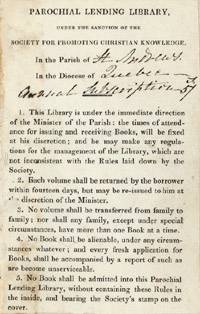Historical Background: The Sunday School Movement
Robert Raikes and Thomas Stock first established a Sunday school for the poor and orphaned in Gloucester in 1780. Although there were earlier Sunday schools, Raikes and Stock have become the recognized originators. Their efforts led clergy and laypeople to establish similar schools throughout England, thus setting in motion the Sunday School Movement. By 1800, 200 000 children were enrolled in English Sunday schools, and by 1850, this number had risen to 2 million.
 |
| An example of the lending rules that students were expected to follow. |
The Sunday schools were organized by people who found that working-class children required some form of discipline. Sunday and evening schools were established to teach reading, writing, arithmetic and catechsim to the 'deserving' poor: enrollment was decided upon by visits with parents, nominations from subscribers, and individual student applications. Students were expected to attend school four to five hours per week, and was the only schooling that most working class children ever received. Although originally hailed as a great and noble achievement, Sunday schools constantly struggled for survival:
- there was often ecclesiastical pressure to not teach writing on a Sunday
- debates raged as to whether teaching the lower classes was, in fact, a good idea; there were worries that such education would lead them to forget their station in life
- the Church of England was often unable to support the schools, or provide them with adequate space or funds
Consequently, the schools were financed by subscribers, who were encouraged to nominate children for enrollment. They were also encouraged to visit the schools in order to hear the children repeat their lessons; these subscribers, as such, were the forerunners of school inspectors. The teachers (men and women) were paid, and classes were often held in a person's home, or in rented rooms. Hannah More, for example, held such a school in Blagdon, in 1795. She later became even more influential to the Sunday school movement with the establishment of her Cheap Repository Tracts.
The Sunday schools caught on quickly and were effective because they were simple, became a diversion for the children, and a means for parents to socially elevate the family as a whole. They were often also a means of education for adults, who occasionally attended the schools; children were actively encouraged to take lessons and books home to share with their parents.
The Sunday school also became an important hub of social interaction for a class of children and parents who were rapidly moving away from small, close-knit, rural communities to large, over-populated, urban centres. Lastly, the schools taught catechism to a population that, until that time, only learned it via a rote memorization system with the priest reciting the Lord's Prayer one line at a time, once a week, during the service. As the schools gained in popularity and effectiveness, the Church of England started to actively provide them with facilities and finances. This also meant a tighter control over their management and curriculum, rather than allowing lay people to continue running the schools.
